Order "Islands of the Sun"
Islands of the Sun: A Tribute to the Northern Exuma Cays, Bahamas
by John A. Thompson and Nikita Shiel-Rolle. 2009.
Book review published in
Bulletin of Marine Science 85(3): 284-285, 2009
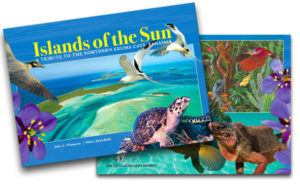 During the winter of 1725–26,English naturalist Mark Catesby visited the Bahamas to collect specimens of plants and birds, a stopover on a trip that would also take him to other parts of the eastern U.S. and the West Indies. The resulting publication of this voyage, a sumptuous work entitled The natural history of Carolina, Florida, and the Bahama Islands, was issued in London between 1731 and 1743, and contained over 200 plates of “birds, beasts, fishes, serpents, insects and plants.” With this publication, Catesby not only provided the first published account of the flora and fauna of North America but greatly advanced the art of illustrating. Cromwell Mortimer, reviewing the publication for The Royal Society Philosophical Transactions hailed it as “the most magnificent work I know since the art of printing has been discovered.”
During the winter of 1725–26,English naturalist Mark Catesby visited the Bahamas to collect specimens of plants and birds, a stopover on a trip that would also take him to other parts of the eastern U.S. and the West Indies. The resulting publication of this voyage, a sumptuous work entitled The natural history of Carolina, Florida, and the Bahama Islands, was issued in London between 1731 and 1743, and contained over 200 plates of “birds, beasts, fishes, serpents, insects and plants.” With this publication, Catesby not only provided the first published account of the flora and fauna of North America but greatly advanced the art of illustrating. Cromwell Mortimer, reviewing the publication for The Royal Society Philosophical Transactions hailed it as “the most magnificent work I know since the art of printing has been discovered.”
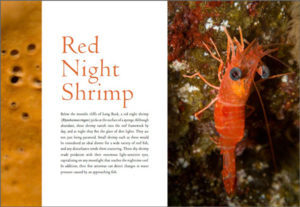 Following in Catesby’s footprints, Bahamian-born John A. Thompson and Nikita Shiel-Rolle have once again captured the exuberant natural history of the region with Islands of the sun: a tribute to the northern Exuma Cays, Bahamas, a mighty 438-page pictorial volume that pays homage to “the diverse environments of the northern Exuma Cays.” Thompson (credited with text and illustrations) and Shiel-Rolle (photography), are gifted vicenarians at the onset of their professional careers. Islands is their first book, an effort made possible by The Danguillecourt Project (now Bahamas Marine EcoCentre), a Bahamian non-profit organization that promotes awareness, appreciation, and stewardship of the Bahamian environment through education.
Following in Catesby’s footprints, Bahamian-born John A. Thompson and Nikita Shiel-Rolle have once again captured the exuberant natural history of the region with Islands of the sun: a tribute to the northern Exuma Cays, Bahamas, a mighty 438-page pictorial volume that pays homage to “the diverse environments of the northern Exuma Cays.” Thompson (credited with text and illustrations) and Shiel-Rolle (photography), are gifted vicenarians at the onset of their professional careers. Islands is their first book, an effort made possible by The Danguillecourt Project (now Bahamas Marine EcoCentre), a Bahamian non-profit organization that promotes awareness, appreciation, and stewardship of the Bahamian environment through education.
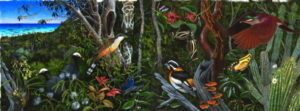 Islands is a tour de force that takes the reader in a voyage of exploration through five distinct environments within the cays: coppice, scrubby coastal vegetation, shorelines, open sandbanks, and coral reefs. The book follows a neat sequence for each habitat. Initially, the habitat is introduced by a gorgeous two-page spread. Thompson’s acrylic-on-canvas renders each habitat in all-embracing glory; trees are in colorful bloom, butterflies and birds dancing at the fore; a lemon shark is gracefully swimming among mangrove roots; a Nassau grouper is emerging from a kaleidoscope of sponge and coral. Next, two pages of text follow with a brief introduction to explain each habitat and its importance. Then, Shiel-Rolle’s photography takes the lead. And what pictures! Her imagery is journalism for the flickr® generation. Classically composed and richly-saturated, every page renders a species of plant, animal or a coastal feature. She composes her shots with care, but seems to favor a close-lense style that collectively conveys a mood of intimacy and solitude; a sharp focal point when necessary, slightly out-of-focus when she wants her subjects to appear fleeting, as if ready to escape one’s gaze. Light and shadow move about the pages at will; a prism of sapphire, turquoise, and azure recurrent of Bahamian waters and sky. Each picture is briefly captioned to convey the right balance of education and fascination; common and scientific names are provided for each creature, and so are bits describing their cultural, culinary or historical value. Finally, each habitat is wrapped with a feature section spotlighting a particular species of interest.
Islands is a tour de force that takes the reader in a voyage of exploration through five distinct environments within the cays: coppice, scrubby coastal vegetation, shorelines, open sandbanks, and coral reefs. The book follows a neat sequence for each habitat. Initially, the habitat is introduced by a gorgeous two-page spread. Thompson’s acrylic-on-canvas renders each habitat in all-embracing glory; trees are in colorful bloom, butterflies and birds dancing at the fore; a lemon shark is gracefully swimming among mangrove roots; a Nassau grouper is emerging from a kaleidoscope of sponge and coral. Next, two pages of text follow with a brief introduction to explain each habitat and its importance. Then, Shiel-Rolle’s photography takes the lead. And what pictures! Her imagery is journalism for the flickr® generation. Classically composed and richly-saturated, every page renders a species of plant, animal or a coastal feature. She composes her shots with care, but seems to favor a close-lense style that collectively conveys a mood of intimacy and solitude; a sharp focal point when necessary, slightly out-of-focus when she wants her subjects to appear fleeting, as if ready to escape one’s gaze. Light and shadow move about the pages at will; a prism of sapphire, turquoise, and azure recurrent of Bahamian waters and sky. Each picture is briefly captioned to convey the right balance of education and fascination; common and scientific names are provided for each creature, and so are bits describing their cultural, culinary or historical value. Finally, each habitat is wrapped with a feature section spotlighting a particular species of interest.
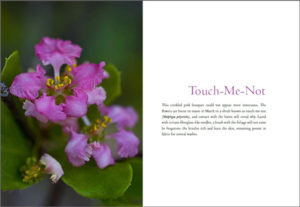 I would add that production work by Neko Meicholas has beautifully completed the artistic quality of Islands . Page numbers are framed in habitat-specific iconography, gorgeous ligatures grace the tastefully-hued serif fonts. Miecholas’s swatches have been chosen with taste, yet sometimes they explode into arches of color to fully participate in the natural landscape. Pages for chapters and focus sections are colorcoded for easy identification.
I would add that production work by Neko Meicholas has beautifully completed the artistic quality of Islands . Page numbers are framed in habitat-specific iconography, gorgeous ligatures grace the tastefully-hued serif fonts. Miecholas’s swatches have been chosen with taste, yet sometimes they explode into arches of color to fully participate in the natural landscape. Pages for chapters and focus sections are colorcoded for easy identification.
Sketches at end of the book provide a convenient key to all inhabitants of Thompson’s canvases, followed by a general index, and a list of Latin names with their corresponding common and Bahamian equivalents providing a helpful inventory of Exumas biology. My preference would have been to increase the font size in this section by a point and sacrifice the general layout for the sake of readability, but that is a matter of predilection, in no way a blemish in the quality and design of the work. No detail was left to chance; for the environmentally- and socially-aware, the book was printed using certified-paper and vegetable-based inks with all proceeds supporting educational activities of The Danguillecourt Project.
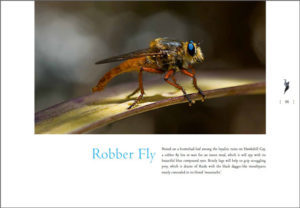 I struggled to find the target user for this volume, accustomed to reading and writing reviews of a more technical nature with a specific readership in mind. Finally I realized the struggle was unwarranted, the target reader all too obvious and wonderfully universal. Any person or institution interested in art, science, and the fusion of vision and knowledge will gain from reading—or just enjoining—this marvelous book. Besides, one should not need justification to enjoy the beauty and splendor of nature.—Rafael J. Araújo, Rosenstiel School of Marine and Atmospheric Science, University of Miami, Miami, Florida 33149.
I struggled to find the target user for this volume, accustomed to reading and writing reviews of a more technical nature with a specific readership in mind. Finally I realized the struggle was unwarranted, the target reader all too obvious and wonderfully universal. Any person or institution interested in art, science, and the fusion of vision and knowledge will gain from reading—or just enjoining—this marvelous book. Besides, one should not need justification to enjoy the beauty and splendor of nature.—Rafael J. Araújo, Rosenstiel School of Marine and Atmospheric Science, University of Miami, Miami, Florida 33149.
Book Order Form

Credit cards accepted or you may use your Paypal account.
Order Prints
Any of the images from ‘Islands of the Sun’ can be custom ordered. Please contact BME for pricing information and ordering. Fill out the form below.

